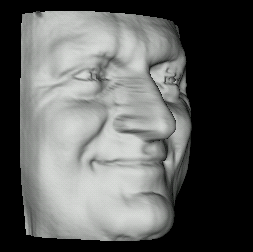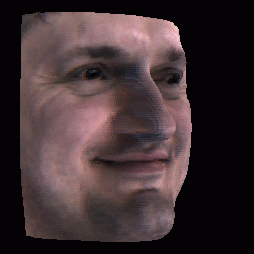Coursework
Before reading further please read the description of the environment and data formats below!The goal of the coursework is to produce a realistic looking 3D rendering of a face. You need to solve ALL THREE of the following tasks:
- Produce and submit three different renderings which show the face rendered using Gouraud shading. You should use different view points and lighting conditions for all three renderings. One of the renderings should have a view point and lighting which is as similar as possible to the renderings shown below.
- Produce and submit one rendering with a texture mapping (see below for details about the texture map and texture coordinates in the data files)
- Produce and submit two animations: In the first animation you should rotate the camera 360 degrees around the face. In the second animation zoom in and out of the face. Both animations should contain at least 20 frames and should be saved as animated gifs (you can use various tools to create animated gifs, for example ImageMagick or gifmerge).
Description
The coursework for the graphics course are practical programming exercises which should be done using OpenGL. The task is to generate different visualizations of a surface model of a face using the data shown below:


Environment
The programming environment for the exercises is OpenGL on the Linux/X11 machines of the department. OpenGL should be installed on all Linux/X11 machines. You can also use the Windows machines in the lab but I recommend to use the Linux environment. You can program either in C or C++. You can download a skeleton OpenGL program (for Linux) from here: Create a new directory in your home directory and download all three files into this directory. To compile the program, go to the new directory and type make. This should compile the sample program for you. To run the sample program, type ./cgRender. The skeleton OpenGL program should create an empty window for you. Take a good look at the skeleton program. It contains a number of hints on how to use OpenGL to start solving the coursework. If you have questions about the coursework come to the tutorials!Data
You can download the data file for an exisiting surface model of a face from here. This surface model consists of vertex coordinates, polygon data and texture coordinates. You can assume that the surface model contains only simple and planar polygons. In addition, you can assume that the surface model is consistent, i.e. the ordering of vertices of the polygons is always the same. The surface model is stored in a file which has the following four parts:- Header. The header contains the following lines:
# vtk DataFile Version 3.0
Somebody's face
ASCII
DATASET POLYDATA
- Vertex data. The first line contains the key word POINTS to indicate the start of the vertex data. The next number equals the number of vertices of the surface model, followed by the type of each vertex (you can assume that this always corresponds to float). Each of the following lines contains the x, y and z world-coordinates for each vertex as floating point numbers.
- Polygon data. The first line contains the key word POLYGONS to indicate the start of the polygon data, followed by the number of polygons and the size of the cell list for all polygons. Each of the following lines contains the number of vertices forming the polygon, followed by the indices of the vertices which form the polygon.
- Texture data. The first line will contain the key word CELL_DATA followed by a number which you can ignore. The next line will contain the keyword POINT_DATA, followed by the number of points with texture coordinates. The next line contains the key word TEXTURE_COORDINATES to indicate the start of the texture data and some misc. information. After that follow lines containing the x and y texture coordinates for each vertex as floating point numbers. The order of the texture coordinates is the same as the order of the vertices.